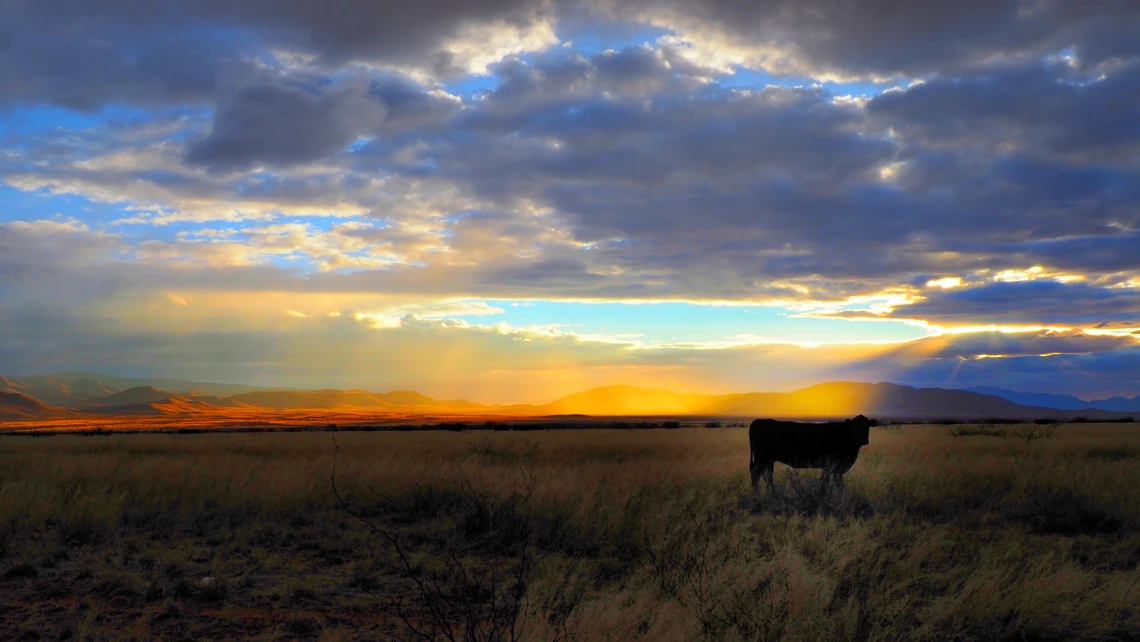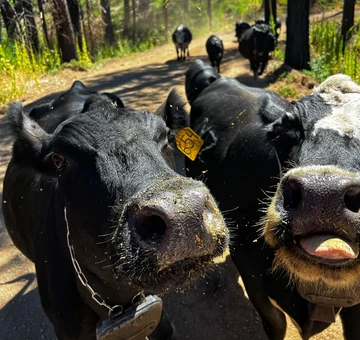University of Arizona research helps keep rangeland healthy and ranches profitable
Cooperative Extension specialists help ranchers monitor land, control livestock and deal with federal grazing leases.

Helping ranchers keep rangeland healthy and profitable are key goals of University of Arizona Cooperative Extension sustainable grazing research and programs.
Cooperative Extension
Arizona ranching has an unbroken history stretching back more than 300 years to Spanish conquistadors, who first brought cattle here in the 1690s.
American ranchers picked up the mantle 150 years ago, and since then cattle ranching has become deeply entrenched in the state’s identity. But keeping that culture alive has grown increasingly difficult as rainfall dwindles and temperatures rise.
Keeping ranch culture and the land it relies on alive are core goals of University of Arizona Cooperative Extension’s research and education in sustainable grazing.
What is sustainable grazing?
Ashley Hall, a University of Arizona Cooperative Extension associate area agent who administers Extension’s Reading the Range monitoring program, defined sustainable grazing as following best science-based management practices to maintain healthy rangelands, ensuring that it’s productive for livestock and wildlife.
Under that umbrella is a wide array of actions that help ranchers and public land managers, usually with state or federal governments, maintain balance between legally-required access to public grazing land and a healthy ecosystem.
Some sustainable grazing practices include monitoring vegetation response to the grazing carrying capacity of the land. Grazing management tools such as rotational or deferred grazing, allows land to rest and recover for an entire year or part of the growing season after grazing, Hall said.
“And that's becoming more critical with the current drought conditions we're in, because the drought is really having an impact,” she said.
Another sustainable management tool is the timing of grazing. Some pastures have different grasses growing at different times of year (cool or warm season plants). Keeping the land healthy might require managing the time grazing occurs to maximize livestock performance, Hall said.
Extension specialists monitor vegetation for forage availability and assess soil health and other aspects of the range. That information can help ranchers decide where and when to graze cattle.
Decades ago, ranchers could run many more cattle per acre. As the carrying capacity of the range drops, managing it carefully to protect the land becomes ever more important.
Ranchers on leased public land are required to follow guidelines published by public land management agencies, in Arizona most often the Bureau of Land Management or Forest Service. Despite the perception that ranchers resent federal oversight, Hall believes many would follow sustainable practices even if it wasn’t required.
“I think it goes back to protecting vegetation and soil resources, because if you don't have healthy soils, you don't have healthy rangelands. You can't make money, because there's nothing for your cows to eat,” she said.
Extension fostering cooperation
Two years ago, Extension signed a memorandum of understanding with Prescott National Forest, Yavapai Cattle Growers, Arizona Cattle Growers Association and the Arizona Association of Conservation Districts, a state organization representing Natural Resource Conservation Districts in Arizona.
The groups agreed to cooperate on rangeland data collection and sharing. Prior to the agreement, the leased federal land was monitored using non-peer-reviewed methods, leading to invalid data in some cases. The agreement ensures that everyone is on the same page when grazing decisions are made, said Mohave County Extension Director Andrew Brischke, an area assistant agent.
Data is collected using science-based protocols and methods, then stakeholders, including grazing permittees, collaborate on interpreting the information.
“Then we can all come together again and make appropriate management decisions, depending on what the data is telling us,” Brischke said.
A key goal of the agreement is relationship building. Before the memorandum of understanding, there were disagreements about monitoring methods and interpretation of the information.
Because the agreement applies to grazing allotments on national forest land, Prescott National Forest has the final say on grazing decisions. The agreement ensures that ranchers and other stakeholders have input. Grazing permit holders are responsible for implementing agreed-upon plans, Brischke said.
The agreement is good for ranchers, because they will have more reliable data about their allotments going forward. It also helps dispel some of the longstanding tension between ranchers and public land managers.
“It's difficult to agree on any management decision, but as long as you have the monitoring data as the foundation for those management decisions, then you have something to stand on,” Brischke said.
Having multiple stakeholders offer input into management decisions keeps the bar high when decisions are made, he said.
“It's just bringing more ideas through different lenses to get the best possible management decision we can. That's going to improve the sustainability of the rangelands.”
Monitoring helps ranchers measure the success of their decisions, which can have very long-ranging consequences. The goal is sustaining the land for generations, Brischke said.
“We learned in the late 1800s, early 1900s that we were simply overgrazing our land. It was unsustainable. This monitoring measures the response to our management - if we're doing a good job, or if we're doing a bad job. And if we're doing a bad job, we need to make changes,” he said.
The stakes are high. Damage the land enough, and it becomes impossible or too expensive to restore, Brischke said.
“Rangelands are renewable, natural resources that require appropriate grazing to stay healthy. Appropriate management decisions give our rangelands the capability to recover after grazing, a fire event or after a drought,” he said.
Overall Brischke sees healthy rangeland in Arizona.
“Our rangelands are very resilient and sustainable, generationally,” he said.
“We've been grazing in Arizona for well over 150 years, and we're still going, so it’s sustainable. Through research, monitoring, and I only see our management decisions improving and being more timely, allowing our rangelands to be even more sustainable than people may think.”
Extension testing high tech livestock management
Technology is becoming widespread among ranchers. Four-wheelers have replaced horses on many ranches, and drones are becoming more common for surveying fences and land. Virtual fencing is also gaining traction.
Assistant Professor and Assistant Extension Specialist Flavie Audoin is studying the effectiveness and feasibility of this emerging GPS technology, which uses a combination of auditory and electrical cues to influence livestock movement.

Virtual fence collars like the one at left can help ranchers control where cattle go. The electronic systems offer more flexibility than traditional, physical fencing.
Cooperative Extension
“It's kind of a very hot topic right now. Everybody talks about it, not just in Arizona, but in a lot of states around the U.S. A lot of universities are doing research on virtual fence,” Audoin said.
There are no physical barriers or sensors in the pastures; the technology works through GPS and collars worn by livestock. All virtual fence systems rely on some cellular connection. Some systems rely on cellular networks only, and others use base stations.
Virtual fencing can’t replace physical fencing completely. Ranches that use it still have perimeter fences to keep livestock on the property, but inside that fence, livestock can be controlled electronically.
Although virtual fencing is getting a lot of attention, it’s expensive. As of July 2025, just four companies offer the technology in the U.S. One of Audoin’s research goals is testing the various systems to help ranchers determine – before they make the investment – if virtual fencing meets their needs and which system is best for them, she said.
Virtual fencing is more flexible than physical fences as virtual fences can be easily moved around a pasture depending on the ranchers’ goals.
It allows ranchers to subdivide their pastures and keep cattle away from certain areas at specific times of year. For example, the technology could be used to keep livestock away from toxic plants like locoweed. This use has not been tested yet. It can also potentially keep livestock out of sensitive places like riparian areas or areas where endangered species are nesting or breeding, Audoin said.
The invisible barriers can even be used for wildfire protection. Livestock can be guided into small areas to clear vegetation for firebreaks, she said.
Some ranchers are hesitant to use the technology. The reasons vary, Audoin said.
Aside from the initial expense of the collars and with some systems including base stations, there is a learning curve. Some ranchers fear hackers could get into the computer- and phone-based systems, but this risk is extremely low, Audoin said.
Customer service could also be an issue. If physical fencing fails, you ride out and fix it. If virtual fencing fails, you might have to call customer service she said.
Extension’s role in sustainable grazing is multifaceted, but giving ranchers and land managers the data they need to keep land healthy underlies all Extension sustainable grazing work. Hall believes ranchers and land managers have the same goals in many cases.
“Ranchers are conservationists in their own way. They're interested in protecting the land for future generations. At the end of the day, it's their decision how they manage their herd, or what technologies they might implement. We're just here to give them the tools that they might need to succeed,” Hall said.
To learn more about Extension monitoring programs, see our Rangeland Monitoring page. For more information about virtual fencing, see these Extension publications.

